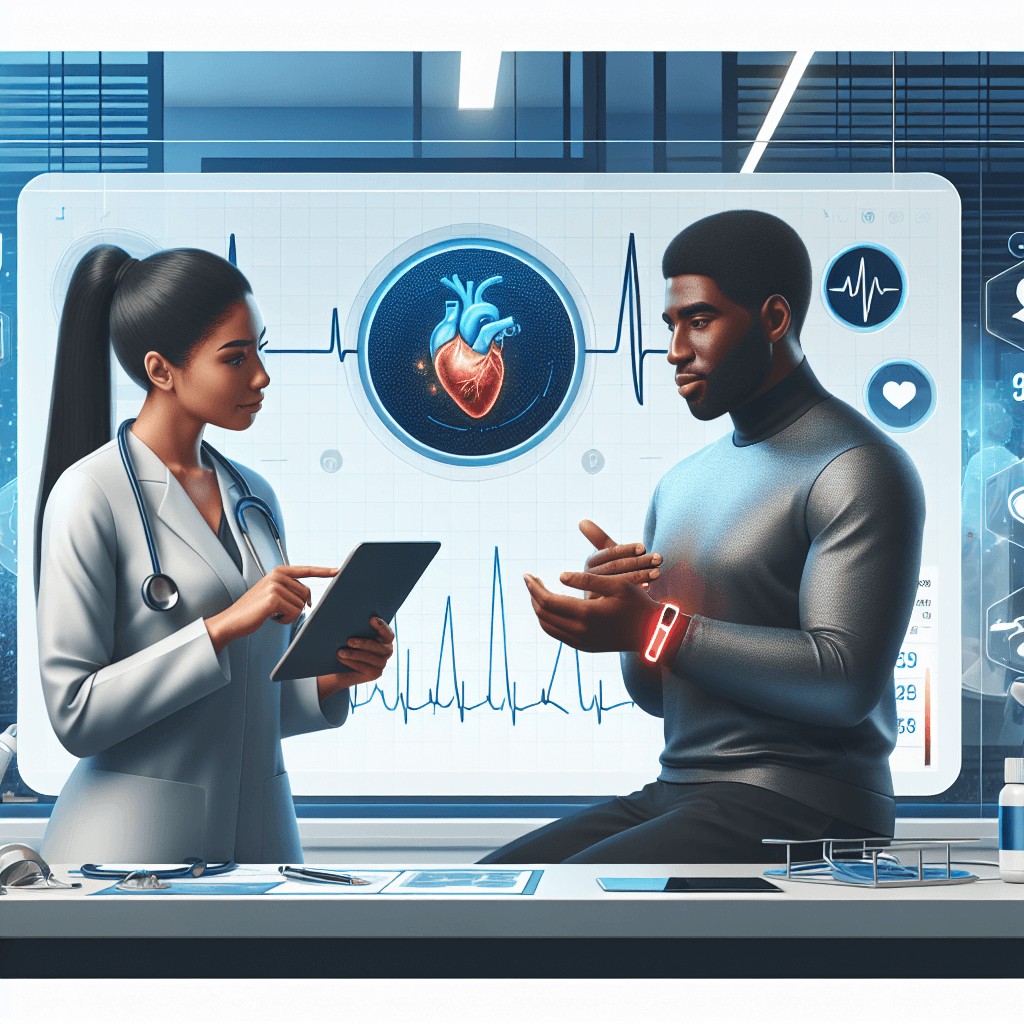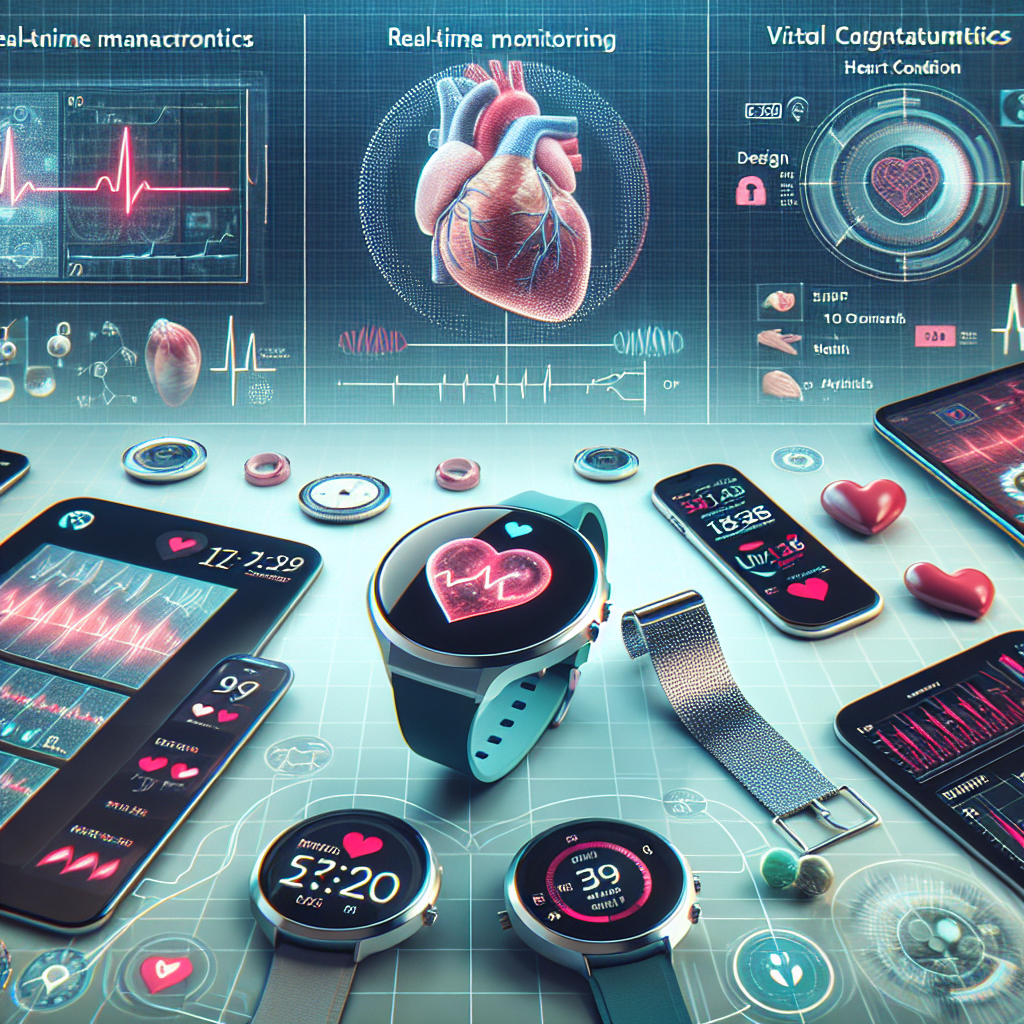In the fast-paced world of healthcare, the integration of wearable technology has revolutionized the way heart conditions are managed. With the ability to monitor vital signs in real-time and provide continuous feedback, wearable tech devices offer a new level of convenience and empowerment for patients. From smartwatches to wireless ECG monitors, this article explores the various types of wearable technology available, their benefits, and the impact they have on the management of heart conditions. Discover how these innovative devices are transforming the way healthcare professionals approach the monitoring and treatment of cardiac health.
Table of Contents
Benefits of Wearable Tech in Managing Heart Conditions
Real-time Monitoring
One of the key benefits of wearable tech in managing heart conditions is the ability to provide real-time monitoring of vital signs. Wearable devices such as heart rate monitors, blood pressure monitors, smartwatches, and activity trackers can continuously track important metrics related to cardiac health. This real-time monitoring allows individuals to have constant awareness of their heart rate, blood pressure, and other relevant parameters. By providing immediate feedback, wearable tech enables individuals to make quick decisions regarding their health and seek medical attention if necessary.
Early Detection of Symptoms
Wearable tech also plays a crucial role in the early detection of symptoms related to heart conditions. By continuously monitoring various parameters, these devices can identify irregularities or changes that may indicate the onset of a cardiac event. For example, a heart rate monitor can detect abnormal heart rhythms or an elevated heart rate, prompting the individual to seek medical attention before a more serious event occurs. Early detection of symptoms can significantly improve outcomes for individuals with heart conditions, allowing for timely intervention and treatment.
Improved Communication with Healthcare Providers
Another advantage of wearable tech in managing heart conditions is the improved communication it allows between individuals and their healthcare providers. With the integration of wearable devices and telemedicine platforms, individuals can easily share their real-time data with their healthcare team. This facilitates remote patient monitoring, virtual consultations, and automated data sharing. Through these means, healthcare providers can have a more comprehensive understanding of an individual’s heart health, enabling them to provide personalized and timely care. This improved communication can lead to better treatment decisions, increased patient engagement, and ultimately, enhanced healthcare outcomes for individuals with heart conditions.
Types of Wearable Devices for Heart Conditions
Heart Rate Monitors
Heart rate monitors are one of the most commonly used wearable devices for managing heart conditions. These devices can be worn as wristbands or chest straps and accurately measure an individual’s heart rate in real-time. By continuously monitoring heart rate, individuals can gain insights into their cardiovascular health, track their fitness levels, and detect any abnormalities or irregularities in heart rhythm. Heart rate monitors are particularly useful for individuals with arrhythmias, as they can help identify episodes of irregular heartbeats and enable timely intervention.
Blood Pressure Monitors
Wearable blood pressure monitors are another type of device commonly used in the management of heart conditions. These devices often come in the form of wristbands or upper arm cuffs and provide continuous blood pressure monitoring throughout the day. By regularly measuring blood pressure, individuals can track their hypertension levels, monitor the effectiveness of medication or lifestyle changes, and work towards maintaining optimal blood pressure. Wearable blood pressure monitors are especially beneficial for individuals with cardiovascular diseases such as hypertension and can assist in preventing complications such as stroke or heart attack.
Smartwatches
Smartwatches have gained popularity in recent years and offer a range of health-related features that make them valuable tools for managing heart conditions. These devices typically include heart rate monitoring, sleep tracking, activity tracking, and other health-related functionalities. Smartwatches can provide a comprehensive overview of an individual’s heart health, allowing them to monitor their heart rate and activity levels throughout the day. Some smartwatches even include features like electrocardiogram (ECG) recording, which can help detect irregular heart rhythms and provide actionable insights.
Activity Trackers
Activity trackers are wearable devices specifically designed to monitor physical activity levels throughout the day. They often come in the form of wristbands or clip-on devices and can track metrics such as steps taken, distance traveled, calories burned, and active minutes. For individuals with heart conditions, activity trackers are useful tools for promoting physical activity and encouraging a healthy lifestyle. By monitoring their daily activity levels, individuals can set goals, track their progress, and make informed decisions about their exercise routine. Regular physical activity can have significant benefits for heart health, including improved cardiovascular fitness, weight management, and reduced risk of heart disease.

Role of Wearable Tech in Preventive Care
Promoting Physical Activity
One of the primary roles of wearable tech in preventive care for heart conditions is promoting physical activity. Regular exercise is essential for maintaining cardiovascular health and reducing the risk of heart disease. Wearable devices such as activity trackers and smartwatches can track an individual’s steps, distance, and active minutes, providing real-time feedback on their activity levels. By setting daily goals and monitoring their progress, individuals are motivated to engage in regular physical activity, leading to improved fitness and overall heart health.
Encouraging Healthy Lifestyle Choices
Another important role of wearable tech in preventive care is to encourage individuals to make healthy lifestyle choices. Wearable devices can provide reminders and alerts to promote behaviors such as taking medication on time, staying hydrated, and practicing stress management techniques. Additionally, some devices offer features like food tracking and calorie counting, which can help individuals make informed dietary choices. By promoting healthy lifestyle behaviors, wearable tech can contribute to the prevention of heart conditions and support individuals in managing existing heart conditions.
Monitoring Sleep Patterns
Wearable devices can also play a role in monitoring sleep patterns, which are closely linked to heart health. Lack of sleep or poor sleep quality can contribute to an increased risk of developing heart conditions and can worsen existing conditions. Sleep tracking features in devices such as smartwatches can monitor an individual’s sleep duration, sleep stages, and provide insights into sleep quality. By identifying factors that may be disrupting sleep, individuals can take steps to improve their sleep habits and ultimately support their heart health.
Managing Stress Levels
Stress management is crucial for individuals with heart conditions, as chronic stress can have a negative impact on cardiovascular health. Wearable devices that incorporate features such as heart rate variability monitoring and guided breathing exercises can assist individuals in managing their stress levels. Heart rate variability (HRV) is a measure of the variation in time intervals between consecutive heartbeats and is considered an indicator of overall heart health and resilience to stress. By monitoring HRV and offering mindfulness exercises or guided breathing sessions, wearable devices can help individuals regulate their stress response and improve their overall well-being.
Monitoring Heart Conditions with Wearable Tech
Continuous ECG Monitoring
One of the significant advancements in wearable tech for monitoring heart conditions is the capability of continuous electrocardiogram (ECG) monitoring. ECG is a diagnostic test that records the electrical activity of the heart and provides valuable information about heart rate, rhythm, and any abnormalities. Traditional ECGs are typically performed in a clinical setting, but wearable devices such as smartwatches now have the ability to record ECG readings on the go. These devices can detect irregular heart rhythms such as atrial fibrillation (AF) and provide individuals with timely information about their heart health.
Detecting Arrhythmias
Arrhythmias are irregular heart rhythms that can lead to serious complications if left undetected or untreated. Wearable devices that incorporate heart rate monitoring and ECG capabilities can detect arrhythmias and provide individuals with immediate alerts or notifications. This early detection allows individuals to seek medical attention promptly and receive appropriate treatment. By constantly monitoring for arrhythmias, wearable tech can significantly contribute to the management and prevention of arrhythmia-related complications in individuals with heart conditions.
Monitoring Heart Rate Variability
Heart rate variability (HRV) is the variation in time intervals between consecutive heartbeats and is considered an indicator of overall heart health and autonomic nervous system function. Wearable devices that track HRV can provide insights into an individual’s stress levels, recovery from exercise, and general cardiovascular fitness. Low HRV has been associated with an increased risk of heart disease and poor cardiovascular outcomes. By monitoring HRV, wearable tech can alert individuals to potential health risks and encourage behavior changes to improve their HRV and overall heart health.
Tracking Blood Oxygen Levels
Wearable devices equipped with pulse oximetry sensors can track an individual’s blood oxygen levels. Blood oxygen saturation (SpO2) is a measure of how well oxygen is being delivered to the body’s tissues. Monitoring SpO2 can be particularly important for individuals with heart conditions, as low oxygen saturation levels can indicate a reduced supply of oxygen to the heart and other vital organs. By tracking SpO2, wearable tech can provide individuals with valuable insights into their respiratory function and overall cardiovascular health.

Integration of Wearable Tech with Telemedicine
Remote Patient Monitoring
Remote patient monitoring is a key aspect of integrating wearable tech with telemedicine. Wearable devices can continuously monitor an individual’s vital signs and transmit the data to healthcare providers via telecommunication platforms. This allows healthcare professionals to remotely monitor their patients’ condition and detect any changes or abnormalities that may require intervention. Remote patient monitoring can reduce the need for frequent in-person visits and provide individuals with the convenience of receiving care from the comfort of their own homes.
Virtual Consultations
Wearable tech can facilitate virtual consultations between individuals and their healthcare providers. Through video conferencing or telecommunication platforms, individuals can discuss their health concerns, share their real-time data from wearable devices, and receive expert medical advice and guidance without the need for an in-person visit. Virtual consultations can improve access to healthcare, particularly for individuals who may have mobility limitations or live in remote areas. It also allows for more frequent and convenient check-ins, enabling healthcare providers to monitor the progress of their patients and make informed decisions regarding their treatment plans.
Automated Data Sharing
The integration of wearable tech with telemedicine enables automated data sharing between individuals and their healthcare providers. Instead of manually recording and sharing their data during appointments, individuals can have their wearable devices automatically transmit the data to their healthcare team. This seamless data sharing improves the accuracy and timeliness of information, allowing healthcare providers to make more informed decisions about an individual’s condition. Automated data sharing also reduces the burden on individuals to manually track and report their health metrics, making the management of heart conditions more efficient and streamlined.
Alerts and Notifications
Wearable tech integrated with telemedicine can provide individuals with alerts and notifications based on their real-time health data. For example, if a wearable device detects a critical change in heart rate or blood pressure, it can automatically send an alert to the individual’s healthcare provider, who can then reach out to the individual and provide appropriate guidance or intervention. Alerts and notifications can also remind individuals to take their medication, adhere to their treatment plan, or engage in healthy behaviors. This proactive approach to care can improve medication adherence, support self-management, and ultimately contribute to better outcomes for individuals with heart conditions.
Challenges and Limitations of Wearable Tech
Accuracy and Reliability
One of the primary challenges of wearable tech for managing heart conditions is ensuring accuracy and reliability of the data collected. While advancements in sensor technology have greatly improved the accuracy of wearable devices, there can still be variations in measurements compared to gold standard clinical devices. It is crucial for individuals and healthcare providers to understand the limitations of wearable devices and interpret the data with caution. Calibration and regular validation against clinical measurements can help improve accuracy, but ongoing research and development are necessary to overcome these challenges.
User Adoption and Compliance
Another challenge is user adoption and compliance with wearable tech. While some individuals may readily embrace the use of wearable devices, others may be hesitant or resistant to incorporating them into their daily lives. Factors such as discomfort, inconvenience, or lack of technological literacy can impact user adoption. Additionally, individuals may not consistently adhere to wearing the devices or following the recommendations provided by the wearable tech. Overcoming these barriers requires education, support, and addressing the individual needs and preferences of users to maximize the benefits of wearable tech in managing heart conditions.
Data Security and Privacy
The collection and transmission of personal health data through wearable tech raise concerns about data security and privacy. The sensitive nature of health information requires robust security measures to protect individuals’ data from unauthorized access or breaches. Wearable tech companies and healthcare providers must prioritize data encryption, secure storage, and adherence to privacy regulations to ensure the confidentiality of personal health data. Transparent communication about data privacy policies and obtaining the informed consent of individuals are essential to build trust and ensure the responsible use of wearable tech in managing heart conditions.
Interoperability and Standardization
Interoperability and standardization of wearable tech systems present significant challenges in integrating these devices into existing healthcare systems. Different wearable devices may use proprietary algorithms and formats for collecting and analyzing data, making it difficult to exchange and aggregate data across different platforms. Interoperability standards and the seamless integration of wearable tech with electronic health records (EHRs) are crucial for healthcare providers to access and utilize the data effectively. Collaborative efforts among wearable tech manufacturers, software developers, and healthcare providers are needed to develop standardized protocols and ensure interoperability for better care coordination and management of heart conditions.

Future Trends in Wearable Tech for Heart Conditions
Advancements in Sensor Technology
Continued advancements in sensor technology are expected to drive future trends in wearable tech for managing heart conditions. Sensors that can provide more accurate and detailed data about cardiovascular health, such as blood pressure monitoring without the need for cuffs or electrodes, are being developed. These advancements will enhance the capabilities of wearable devices, enabling individuals and healthcare providers to make more informed decisions about the management and prevention of heart conditions.
Artificial Intelligence and Machine Learning
The integration of artificial intelligence (AI) and machine learning (ML) algorithms into wearable tech is another significant trend for the future. AI and ML can analyze large datasets collected by wearable devices and provide actionable insights for individuals and healthcare providers. These algorithms can detect patterns, predict trends, and personalize recommendations based on an individual’s unique health data. As AI and ML technologies continue to evolve, wearable tech for heart conditions can become even more precise, efficient, and tailored to the needs of individuals.
Integration with Implantable Devices
The integration of wearable tech with implantable devices is an emerging trend with the potential to revolutionize the management of heart conditions. Implantable devices such as pacemakers, defibrillators, and cardiac monitors can collect detailed data about an individual’s heart health from within the body. By integrating these implantable devices with wearable tech, individuals can have a comprehensive view of their cardiac health, both externally and internally. The seamless transmission of data between implantable and wearable devices can enhance the accuracy of monitoring and provide individuals with a more holistic understanding of their heart condition.
Personalized Medicine
Personalized medicine, which focuses on tailoring medical treatment to the individual characteristics and needs of patients, is a future trend that wearable tech can contribute to in managing heart conditions. By collecting and analyzing real-time data about an individual’s heart health, wearable devices can provide personalized recommendations for lifestyle changes, medication adjustments, and treatment plans. By taking into account an individual’s unique physiological characteristics, genetic factors, and environmental influences, wearable tech can support more effective and targeted interventions, leading to improved outcomes and quality of life for individuals with heart conditions.
Case Studies: Successful Implementation of Wearable Tech
Monitoring Cardiac Rehabilitation
Wearable tech has been successfully implemented in cardiac rehabilitation programs, which are designed to help individuals recover and regain their cardiovascular health after a heart attack or cardiac surgery. These programs often include supervised exercise sessions and lifestyle modification guidance. Wearable devices such as heart rate monitors and activity trackers can track an individual’s exercise intensity, duration, and recovery time. This feedback allows healthcare providers to tailor the rehabilitation program to the individual’s needs, monitor progress, and evaluate the effectiveness of the interventions.
Managing Congestive Heart Failure
Congestive heart failure (CHF) is a chronic condition that requires ongoing management to prevent exacerbations and reduce hospitalizations. Wearable tech can play a crucial role in managing CHF by monitoring key parameters such as heart rate, blood pressure, weight, and activity levels. By closely monitoring these metrics, individuals and healthcare providers can detect early signs of fluid retention or worsening heart function, enabling timely interventions and preventing complications. Wearable tech also supports self-management by providing reminders for medication adherence, fluid restriction, and daily weight monitoring.
Preventing Sudden Cardiac Arrest
Sudden cardiac arrest (SCA) is a life-threatening condition that requires immediate medical intervention. Wearable tech, specifically devices with ECG capabilities, can contribute to the prevention of SCA by detecting abnormal heart rhythms such as ventricular fibrillation. These devices can provide individuals with alerts or notifications if a potentially life-threatening arrhythmia is detected. This prompt notification allows individuals to seek medical attention or call for emergency assistance, potentially saving their lives. The integration of wearable tech with automatic external defibrillators (AEDs) can further enhance the response time and improve outcomes in cases of SCA.

Regulatory Framework and Approval Process
FDA Regulations for Medical Devices
In the United States, wearable tech devices intended for medical purposes are regulated by the Food and Drug Administration (FDA). The FDA classifies medical devices based on their level of risk to the user and requires manufacturers to obtain clearance or approval before marketing their products. Wearable devices that are used for diagnosing, treating, or preventing medical conditions, including heart conditions, often fall under the category of Class II or Class III devices. Manufacturers must demonstrate the safety, effectiveness, and quality of their devices through pre-market notification (510(k)) or pre-market approval (PMA) processes.
CE Marking in the European Union
In the European Union, wearable tech devices for managing heart conditions must meet the requirements of the Medical Devices Regulation (MDR) and carry the CE marking to indicate compliance with EU regulations. The CE marking indicates that the device meets essential health and safety requirements and has undergone the necessary conformity assessment procedures. Manufacturers must provide evidence of conformity, including clinical evaluations and assessment of the device’s performance, to obtain the CE marking. The CE marking ensures that wearable devices meet the necessary quality and safety standards before they can be marketed and used in the EU.
Telehealth Reimbursement Policies
Reimbursement for wearable tech devices used in managing heart conditions can vary depending on the healthcare system and insurance coverage in different countries. Some healthcare systems and insurance plans may offer reimbursement or coverage for certain wearable devices if they are prescribed by a healthcare provider for medical purposes. Policies and criteria for reimbursement can also differ based on the specific heart condition being managed. It is essential for individuals to consult with their healthcare providers and insurance providers to understand the reimbursement options available to them for wearable tech devices.
Conclusion
The integration of wearable tech in managing heart conditions offers numerous benefits, including real-time monitoring of vital signs, early detection of symptoms, and improved communication with healthcare providers. Various types of wearable devices, such as heart rate monitors, blood pressure monitors, smartwatches, and activity trackers, play a role in managing heart conditions by promoting physical activity, encouraging healthy lifestyle choices, monitoring sleep patterns, and managing stress levels. Wearable tech enables continuous monitoring of heart conditions through features such as continuous ECG monitoring, arrhythmia detection, heart rate variability monitoring, and tracking blood oxygen levels. The integration of wearable tech with telemedicine facilitates remote patient monitoring, virtual consultations, automated data sharing, and alerts/notifications. However, challenges related to accuracy, user adoption, data security, and interoperability need to be addressed. Future trends in wearable tech for heart conditions include advancements in sensor technology, the integration of AI and ML algorithms, the integration with implantable devices, and personalized medicine. Successful case studies demonstrate the effectiveness of wearable tech in monitoring cardiac rehabilitation, managing congestive heart failure, and preventing sudden cardiac arrest. It is important to navigate the regulatory framework, including FDA regulations and CE marking, and understand telehealth reimbursement policies for wearable tech devices. Overall, wearable tech empowers patients in managing their heart conditions and enhances healthcare outcomes through technology.


